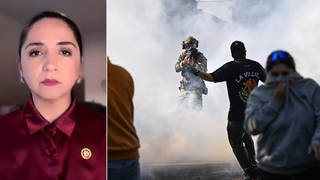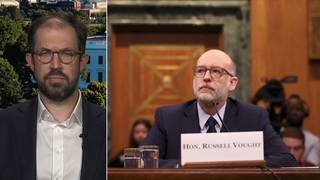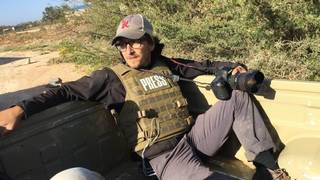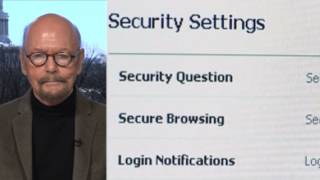
Topics
Guests
- Tim Shorrockauthor of the article on Salon.com, “Exposing Bush’s Historic Abuse of Power.” He is an investigative reporter and author. His latest book is titled Spies for Hire: The Secret World of Intelligence Outsourcing.
Salon.com has published new details about a top secret government database that might be at the heart of the Bush administration’s domestic spying operations. The database is known as “Main Core.” It reportedly collects and stores vast amounts of personal and financial data about millions of Americans. Some former US officials believe that “Main Core” may have been used by the National Security Agency to determine who to spy on in the immediate aftermath of 9/11. We speak with author and investigative journalist, Tim Shorrock. [includes rush transcript]
Transcript
AMY GOODMAN: On Capitol Hill, the House Judiciary Committee is set to hold a hearing today on Congress member Dennis Kucinich’s measure to impeach President Bush. Part of the hearing is expected to examine the administration’s surveillance, detention, interrogation and rendition programs.
The hearing comes as new details emerge about the Bush administration’s domestic surveillance operations. Salon.com reports Democratic leaders on Capitol Hill are being urged to conduct a sweeping investigation into the White House’s domestic surveillance program along the lines of the famous Church Committee investigations of the ’70s.
Salon has also published new details about a top secret government database that might be at the heart of the Bush administration’s domestic spying operations. The database is called “Main Core.” It reportedly collects and stores vast amounts of personal and financial data about millions of Americans. A former intelligence officer told Salon.com the database was “designed for use by the military in the event of a national catastrophe, a suspension of the Constitution, or the imposition of martial law.” Some former US officials believe Main Core may have been used by the National Security Agency to determine who to spy on in the immediate aftermath of 9/11.
Tim Shorrock wrote the piece in Salon.com. His latest book, by the way, is called Spies for Hire: The Secret World of Intelligence Outsourcing.
So, Tim, tell us about this database and its significance.
TIM SHORROCK: Well, from what I’ve been able to learn about it, it dates back to the Reagan administration. There’s a program that’s been in place since about 1983 called the Continuity of Government program, and this was basically to preserve government functions in case of a nuclear war, catastrophic attack —-
AMY GOODMAN: The COG.
TIM SHORROCK: Yeah, the COG. And it was actually run by -— under the Reagan administration, by former president and former vice president George H.W. Bush. But this program was basically, you know, to disperse people to different parts of the country when the government was attacked, when the country was attacked.
And people that were involved in this program from the Bush administration include Vice President Cheney and Donald Rumsfeld, and actually Cheney’s Chief of Staff David Addington, were all involved in sort of practice runs, where they would suddenly get a call and be told to go to a certain place to practice this Continuity of Government exercise. And they did this through the ’80s, a little bit in the 1990s. President Clinton apparently sort of deemphasized this whole plan. But it came back, and a version of it was run during the 9/11 emergency, when, you know, we remember Vice President Cheney always going to undisclosed locations, but many other officials and Congress people went with him to various places to carry on the functions of government.
Now, when this program was created during the Reagan administration, there was a database, some kind of watch list that they used, that was developed to keep track of Americans that the government believed were threats to national security, subversives, in some way. And there were different incidents where information about this database came out. For example, there were stories in both the Miami Herald and some newspapers in Texas, the Austin Herald-American, that reported about this database and how Oliver North, who was very involved in the Iran-Contra controversy when he was working at the White House, was actually using this — might be using this database as a way to keep track of, say, Central American immigrants and people opposed to US policy in Central America during the 1980s. And at one point during the Iran-Contra hearings, Representative Jack Brooks of Texas focused on this and asked Oliver North about this database, which at that time was believed to be controlled by the Federal Emergency Management Administration, FEMA. And immediately, Senator Dan Inouye, who was the chairman of the Iran-Contra hearings, cut him off, said that’s — “That deals with very sensitive classified information. We can’t talk about it.” And it was never really discussed. And there’s been articles about it.
And I began to learn a few months ago that this database, which some people now call “Main Core,” is still in existence and actually is being used by US intelligence agencies as a way to keep track of Americans and also run names — apparently, it holds all kinds of information on millions of Americans. There was an article recently also in Radar magazine, where they said eight million names are in this database. And what I’ve been told is that the database still exists. Of course, it was still created for martial law circumstances and in a period of absolute crisis in the United States where there would be sort of military government in place in different parts of the country. An extreme measure, in other words.
And what I’ve been told also is that this could have been the root of the dispute, when, as people may remember, the Attorney General John Ashcroft and some of his deputies, when they reviewed the NSA’s surveillance eavesdropping program that was operating without warrants, decided that something was illegal about the program, and they had a confrontation in John Ashcroft’s hospital room, and the dispute went on for some weeks until it was resolved by President Bush. But I’ve been told that it’s very likely that that dispute focused on those databases — on this one database and its use by the NSA to look at specific Americans and as a way to do the eavesdropping. Now, we don’t know this for sure. I reported it in the context of, there is this push to have some kind of investigation of the Bush administration’s policies on intelligence and that this should certainly be an area that should be looked at.
AMY GOODMAN: Can you explain more about Inslaw, about the past, and also comparisons with the possibility of a Church Commission — Church Committee investigation?
TIM SHORROCK: Well, Inslaw is a company that produces computer software for the government, and it’s been doing it for many years. It was started by a guy named Bill Hamilton, who was actually in the National Security Agency during the 1960s. He produced a software that’s been used for years in the Justice Department to keep track of cases that are filed against, you know, anybody, to keep track of criminal cases as they’re carried through the Justice Department. And apparently it has a very strong — you know, very good searching capabilities. It operates kind of like Google, but it was invented long before Google was ever around. It can search databases very quickly and come up with all kinds of information.
And Inslaw has had a claim for many years that’s been investigated by several committees of Congress, of various courts, where he claims that this software was basically stolen by the Reagan administration Justice Department, misappropriated and given to the NSA, the National Security Agency, and the CIA as a way for them to keep track of intelligence cases because of its very strong search capabilities. And he has a lot of evidence to show this, that it was investigated. He hired lawyers like Elliot Richardson, the former Secretary of Defense, to take his case to the CIA and various intelligence officials. In my story, actually — his software was called “PROMIS” — P-R-O-M-I-S — and in my story that was in Salon the other day, I did get a former National Security Council official, who used to work very closely with the NSA on tracking financial transactions around the world, say that in fact the NSA had used this software as the basis for its searching. So there is definitely some evidence that, you know, the software, which Hamilton and Inslaw claim is the basis of this Main Core database, you know, was used by US intelligence agencies.
Now, as far as the Church Committee idea, what I reported was that there were meetings — there’s been meetings held primarily on the House side, with House Democrats and their aides, various organizations that are concerned about civil liberties, like the ACLU, sort of saying, “You know, look, we’ve had a very difficult time uncovering all of what’s happened under Bush and Vice President Cheney in terms of, you know, policies on torture, interrogation, rendition, the whole surveillance program, the whole warrentless surveillance program. Maybe there should be another Church Committee, as was set up during the 1970s to look at intelligence abuse.”
And I obtained a document, a memo that was written sort of as a think piece, that was written by a former senior member of the Church Committee. And in this memo, he outlined how it would work. And one of the interesting things about the memo was the suggestion that any investigation like this would have to go back to earlier administrations. In other words, there’s been a lot of terrible things, and very questionable things have happened under Bush and Cheney, but we don’t know the origins of these programs, and it would be important to go back to look at how they actually began and go back to this Reagan administration Continuity of Government, for example, and see what the roots of any kind of, you know, database that might have been — might be used, targeted at the American people.
And the Church Committee itself, if people remember, actually went back to the days of Franklin Roosevelt. So it was started during ’70s under Nixon because of reports in the New York Times and other media by Seymour Hersh and reporters like him, who exposed the CIA’s domestic spying on Americans. And then the Church Committee got started in the Senate, chaired by Senator Frank Church. There was an accompanying House committee, as well. And they looked at all aspects of US intelligence, and in particular, they looked at this whole use of watch lists by various agencies like the FBI and the CIA, and they exposed, during the Church hearings — that’s how the whole NSA spying came out, because they got the whole story about how the NSA had been listening in on the phone calls of many prominent antiwar activists, African American organizations, civil rights leaders, and so on. And they exposed the various programs of the NSA.
And that’s how the Foreign Intelligence Surveillance Act emerged, was the Congress did not want to have the rights of Americans, the civil liberties, abused by their intelligence services anymore, and so they passed FISA as a way to require warrants, when there is any kind of monitoring of Americans in the United States by the NSA. And that was the guiding law until it was recently changed by Congress.
AMY GOODMAN: We’re going to have to leave —-
TIM SHORROCK: So this need -—
AMY GOODMAN: Tim, you have thirty seconds.
TIM SHORROCK: Well, so there’s this — you know, so people are saying, look, Bush and Cheney have done a lot. We need —- they’ve stonewalled Congress. We’ve gotten little bits and pieces here and there of this story. But we need the full story, and that’s why there’s a need for a committee. I’m not sure if the Democrats will support it, because a lot of them signed off on some of these programs. So I think it needs [inaudible] -—
AMY GOODMAN: Tim Shorrock, I want to thank you for being with us, investigative journalist, author of the piece at Salon.com on Main Core.












Media Options